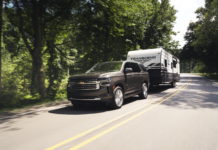For the few who can actually get one, the 2025 Honda CR-V e:FCEV offers a different kind of electric experience.
At first glance, this may just look like your ordinary Honda CR-V crossover — and that’s the point. After announcing its development in late 2022, the hydrogen-fueled version of the automaker’s most popular model finally makes its debut in California. Honda bills its CR-V e:FCEV as an experience broadly like any other CR-V, including a usable 270-mile EPA driving range as well as 29 miles of fully-electric driving without having to take a trip to the fueling station (more on that in a moment).



Co-developed with General Motors, the fuel cell module is meant to expand Honda’s electrified portfolio as it pivots toward 100% zero-emission sales by 2040. Compared to the Clarity Fuel Cell that went out of production several years ago, the automaker says the module costs one-third to build. Honda also packs in a powertrain capable of 174 horsepower and 229 lb-ft of torque, albeit all available output strictly goes to the front wheels.
To create the e:FCEV, the company integrates both the fuel cell and electric motor under the hood, while the 17.7-kWh battery lives under the floor, and the two hydrogen storage tanks reside under the rear seats and cargo floor. Still, despite all the equipment involved, the CR-V e:FCEV still seats five passengers.

Inside, the hydrogen Honda CR-V looks more or less like any other model. You get a 10.2-inch digital instrument cluster, as well as a 9.0-inch infotainment screen with Apple CarPlay and Android Auto support. The control layout largely follows the standard models, with the exception of a slightly revised center console featuring a push-button gear selector setup instead of the conventional lever. Honda Sensing still comes as standard fare, as does wireless phone charging, four selectable drive modes, dual-zone climate control, parking sensors, a 12-speaker Bose audio system and heated/power-adjustable front seats.
So…what’s the catch?
While the 2025 Honda CR-V e:FCEV is billed as conventional a CR-V as any other, there are a few challenges if you’re looking to buy one. First off, you can’t technically buy it: These will only be available later this year through lease plans. On top of that, Honda is only rolling the fuel cell CR-V out in California, as it’s one of the few places with any hydrogen infrastructure.
And about that infrastructure: Shell just permanently closed nearly all of its hydrogen stations in California, citing “supply complications and other external market factors.” Hydrogen has been and remains to this day a limited market, as we’ve seen with the latest Toyota Mirai and the Hyundai Nexo (remember that?).
Several major automakers including Honda, General Motors, Hyundai and Toyota still plan to invest heavily in the hydrogen space, which may help actually make the technology more attainable in the coming years. Even if it doesn’t catch on in passenger cars, some stakeholders see it as a better near-term solution for commercial trucking applications than full battery-electric vehicles.
Honda produces the 2025 CR-V e:FCEV at its Marysville, Ohio plant. While we know the automaker plans to roll these cars out exclusively through a lease program, the company did not announce specific lease terms. Odds are, we’ll know more details on leasing a hydrogen CR-V in the next few months, as we get closer to the actual launch date later this year.



























